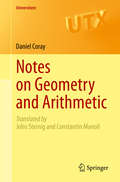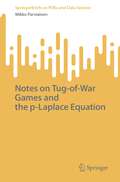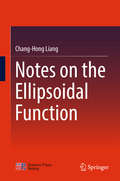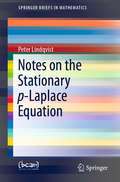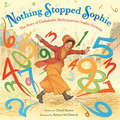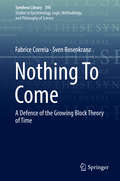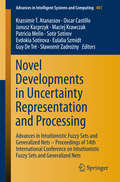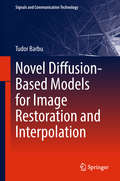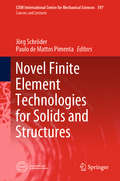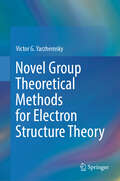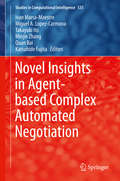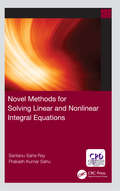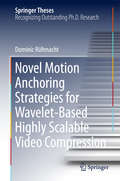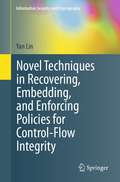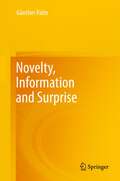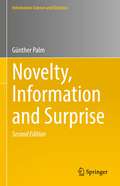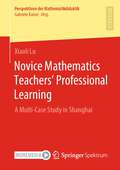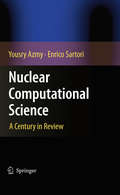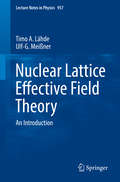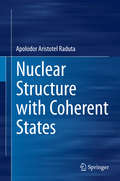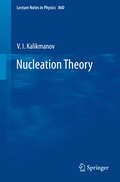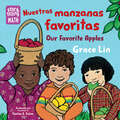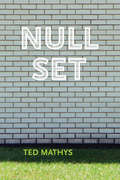- Table View
- List View
Notes on Geometry and Arithmetic (Universitext)
by Daniel CorayThis English translation of Daniel Coray’s original French textbook Notes de géométrie et d’arithmétique introduces students to Diophantine geometry. It engages the reader with concrete and interesting problems using the language of classical geometry, setting aside all but the most essential ideas from algebraic geometry and commutative algebra. Readers are invited to discover rational points on varieties through an appealing ‘hands on’ approach that offers a pathway toward active research in arithmetic geometry. Along the way, the reader encounters the state of the art on solving certain classes of polynomial equations with beautiful geometric realizations, and travels a unique ascent towards variations on the Hasse Principle. Highlighting the importance of Diophantus of Alexandria as a precursor to the study of arithmetic over the rational numbers, this textbook introduces basic notions with an emphasis on Hilbert’s Nullstellensatz over an arbitrary field. A digression on Euclidian rings is followed by a thorough study of the arithmetic theory of cubic surfaces. Subsequent chapters are devoted to p-adic fields, the Hasse principle, and the subtle notion of Diophantine dimension of fields. All chapters contain exercises, with hints or complete solutions. Notes on Geometry and Arithmetic will appeal to a wide readership, ranging from graduate students through to researchers. Assuming only a basic background in abstract algebra and number theory, the text uses Diophantine questions to motivate readers seeking an accessible pathway into arithmetic geometry.
Notes on Numerical Modeling in Geomechanics
by William G. PariseauThis book is an introduction to numerical analysis in geomechanics and is intended for advanced undergraduate and beginning graduate study of the mechanics of porous, jointed rocks and soils. Although familiarity with the concepts of stress, strain and so on is assumed, a review of the fundamentals of solid mechanics including concepts of physical laws, kinematics and material laws is presented in an appendix. Emphasis is on the popular finite element method but brief explanations of the boundary element method, the distinct element method (also known as the discrete element method) and discontinuous deformation analysis are included. Familiarity with a computer programming language such as Fortran, C++ or Python is not required, although programming excerpts in Fortran are presented at the end of some chapters. This work begins with an intuitive approach to interpolation over a triangular element and thus avoids making the simple complex by not doing energy minimization via a calculus of variations approach so often found in reference books on the finite element method. The presentation then proceeds to a principal of virtual work via the well-known divergence theorem to obtain element equilibrium and then global equilibrium, both expressed as stiffness equations relating force to displacement. Solution methods for the finite element approach including elimination and iteration methods are discussed. Hydro-mechanical coupling is described and extension of the finite element method to accommodate fluid flow in porous geological media is made. Example problems illustrate important concepts throughout the text. Additional problems for a 15-week course of study are presented in an appendix; solutions are given in another appendix.
Notes on Tug-of-War Games and the p-Laplace Equation (SpringerBriefs on PDEs and Data Science)
by Mikko ParviainenThis book addresses the interplay between stochastic processes and partial differential equations. More specifically, it focuses on the connection between the nonlinear p-Laplace equation and the stochastic game called tug-of-war with noise. The connection in this context was discovered approximately 15 years ago and has since provided new insights and approaches. These lecture notes provide a brief but detailed and accessible introduction to the subject and to the more research-oriented literature. The book also presents the parabolic case side by side with the elliptic case, highlighting the fact that elliptic and parabolic equations are close in spirit in certain aspects. Moreover, it covers some parts of the regularity theory for these problems. Graduate students and advanced undergraduate students with a basic understanding of probability and partial differential equations will find this book useful.
Notes on the Ellipsoidal Function
by Chang-Hong LiangThis book focuses on the ellipsoidal function, which serves as an evolution and extension of the circular function (trigonometric function) and elliptic function. It presents an in-depth discussion of the ellipsoidal function (algebra) theory and the conformal mapping (geometry) theory of the ellipsoid function, demonstrating the outstanding performance of the ellipsoid function response filter. Applications of the ellipsoidal function include the capacitance of ellipsoidal conductors and the surface area of ellipsoids, which in turn correspond to ellipsoidal integrals of the first kind and the second kind, respectively. The book offers a valuable reference guide for undergraduates, graduate students and researchers in the related fields.
Notes on the Stationary p-Laplace Equation (SpringerBriefs in Mathematics)
by Peter LindqvistThis book in the BCAM SpringerBriefs series is a treatise on the p-Laplace equation. It is based on lectures by the author that were originally delivered at the Summer School in Jyväskylä, Finland, in August 2005 and have since been updated and extended to cover various new topics, including viscosity solutions and asymptotic mean values. The p-Laplace equation is a far-reaching generalization of the ordinary Laplace equation, but it is non-linear and degenerate (p>2) or singular (p
Nothing Stopped Sophie: The Story of Unshakable Mathematician Sophie Germain
by Cheryl Bardoe Barbara McClintockThe true story of eighteenth-century mathematician Sophie Germain, who solved the unsolvable to achieve her dream.When her parents took away her candles to keep their young daughter from studying math...nothing stopped Sophie. When a professor discovered that the homework sent to him under a male pen name came from a woman...nothing stopped Sophie. And when she tackled a math problem that male scholars said would be impossible to solve...still, nothing stopped Sophie.For six years Sophie Germain used her love of math and her undeniable determination to test equations that would predict patterns of vibrations. She eventually became the first woman to win a grand prize from France's prestigious Academy of Sciences for her formula, which laid the groundwork for much of modern architecture (and can be seen in the book's illustrations).Award-winning author Cheryl Bardoe's inspiring and poetic text is brought to life by acclaimed artist Barbara McClintock's intricate pen-and-ink, watercolor, and collage illustrations in this true story about a woman who let nothing stop her.
Nothing To Come: A Defense Of The Growing Block Theory Of Time (Synthese Library #395)
by Fabrice Correia Sven RosenkranzThis monograph is a detailed study, and systematic defence, of the Growing Block Theory of time (GBT), first conceived by C.D. Broad. The book offers a coherent, logically perspicuous and ideologically lean formulation of GBT, defends it against the most notorious objections to be found in the extant philosophical literature, and shows how it can be derived from a more general theory, consistent with relativistic spacetime, on the pre-relativistic assumption of an absolute and total temporal order.The authors devise axiomatizations of GBT and its competitors which, against the backdrop of a shared quantified tense logic, significantly improves the prospects of their comparative assessment. Importantly, neither of these axiomatizations involves commitment to properties of presentness, pastness or futurity. The authors proceed to address, and defuse, a number of objections that have been marshaled against GBT, including the so-called epistemic objection according to which the theory invites skepticism about our temporal location. The challenge posed by relativistic physics is met head-on, by replacing claims about temporal variation by claims about variation across spacetime.The book aims to achieve the greatest possible rigor. The background logic is set out in detail, as are the principles governing the notions of precedence and temporal location. The authors likewise devise a novel spacetime logic suited for the articulation, and comparative assessment, of relativistic theories of time. The book comes with three technical appendices which include soundness and completeness proofs for the systems corresponding to GBT and its competitors, in both their pre-relativistic and relativistic forms. The book is primarily directed at researchers and graduate students working on the philosophy of time or temporal logic, but is of interest to metaphysicians and philosophical logicians more generally.
Novel Developments in Uncertainty Representation and Processing
by Oscar Castillo Patricia Melin Krassimir T. Atanassov Janusz Kacprzyk Sławomir Zadrożny Sotir Sotirov Maciej Krawczak Evdokia Sotirova Eulalia Szmidt Guy De TréThis volume contains, first of all, the papers presented at the Fourteenth International Workshop on Intuitionistic Fuzzy Sets and Generalized Nets (IWIFSGN-2015) held on October 26-28, 2015 in Cracow, Poland. Moreover, the volume contains some papers of a particular relevance not presented at the Workshop. The Workshop is mainly devoted to the presentation of recent research results in the broadly perceived fields of intuitionistic fuzzy sets and generalized nets initiated by Professor Krassimir T. Atanassov whose constant inspiration and support is crucial for such a widespread growing popularity and recognition of these areas. The Workshop is a next edition of a series of the IWIFSGN Workshops organized for years by the Systems Research Institute, Polish Academy of Sciences, Warsaw, Poland, Institute of Biophysics and Biomedical Engineering, Bulgarian Academy of Sciences, Sofia, Bulgaria, and WIT -- Warsaw School of Information Technology, Warsaw, Poland, and co-organized by: Matej Bel University, Banska Bystrica, Slovakia, Universidad Publica de Navarra, Pamplona, Spain, Universidade de Tras-Os-Montes e Alto Douro, Vila Real, Portugal, Prof. Asen Zlatarov University, Burgas, Bulgaria, Complutense University, Madrid, Spain, and the University of Westminster, Harrow, UK.
Novel Diffusion-Based Models for Image Restoration and Interpolation (Signals and Communication Technology)
by Tudor BarbuThis book covers two essential PDE-based image processing fields: image denoising and image inpainting. It describes the state-of-the-art PDE-based image restoration and interpolation (inpainting) techniques, focusing on the latest advances in PDE-based image processing and analysis, and explores novel techniques involving diffusion-based models and variational schemes. The PDE and variational schemes clearly outperform the conventional approaches in these areas, and can successfully remove image noise and reconstruct missing or highly degraded regions, while preserving the essential features and avoiding unintended effects. The book addresses researchers and graduate students, but is also well suited for professionals in both the mathematics and electrical engineering domains, as it provides rigorous mathematical investigations of the image processing models described, as well as mathematical treatments for the numerical approximation schemes of these differential models.
Novel Finite Element Technologies for Solids and Structures (CISM International Centre for Mechanical Sciences #597)
by Jörg Schröder Paulo de Mattos PimentaThis book presents new ideas in the framework of novel, finite element discretization schemes for solids and structure, focusing on the mechanical as well as the mathematical background. It also explores the implementation and automation aspects of these technologies. Furthermore, the authors highlight recent developments in mixed finite element formulations in solid mechanics as well as novel techniques for flexible structures at finite deformations. The book also describes automation processes and the application of automatic differentiation technique, including characteristic problems, automatic code generation and code optimization. The combination of these approaches leads to highly efficient numerical codes, which are fundamental for reliable simulations of complicated engineering problems. These techniques are used in a wide range of applications from elasticity, viscoelasticity, plasticity, and viscoplasticity in classical engineering disciplines, such as civil and mechanical engineering, as well as in modern branches like biomechanics and multiphysics.
Novel Group Theoretical Methods for Electron Structure Theory
by Victor G. YarzhemskyThis book presents the induced representation method, a powerful technique in quantum mechanics with applications in condensed matter physics. After introducing the key concepts in group theory and representation theory necessary to understate the technique, the author goes on to explore applications in electron structure theory, namely: basis sets in clusters, normal vibrations, selection rules, two-electron wavefunctions, and space-group representations. This technique allows the simplification of standard techniques for the analysis of molecular orbitals and normal vibrations of molecules. A space group approach to the wavefunction of a Cooper pair based on the Anderson ansatz and Mackey-Bradley theorem is developed, and several applications are considered, namely group-theoretical nodes, non-symmorphic groups, and unification of the group theoretical and topological approaches to the structure of Cooper pairs in unconventional superconductors.
Novel Insights in Agent-based Complex Automated Negotiation
by Quan Bai Minjie Zhang Takayuki Ito Ivan Marsa-Maestre Miguel A. Lopez-Carmona Katsuhide FujitaThis book focuses on all aspects of complex automated negotiations, which are studied in the field of autonomous agents and multi-agent systems. This book consists of two parts. I: Agent-Based Complex Automated Negotiations and II: Automated Negotiation Agents Competition. The chapters in Part I are extended versions of papers presented at the 2012 international workshop on Agent-Based Complex Automated Negotiation (ACAN), after peer reviews by three Program Committee members. Part II examines in detail ANAC 2012 (The Third Automated Negotiating Agents Competition), in which automated agents that have different negotiation strategies and are implemented by different developers are automatically negotiated in the several negotiation domains. ANAC is an international competition in which automated negotiation strategies, submitted by a number of universities and research institutes across the world, are evaluated in tournament style. The purpose of the competition is to steer the research in the area of bilateral multi-issue, closed negotiation. This book also includes the rules, results, agents and domain descriptions for ANAC 2011 as submitted by the organizers and finalists.
Novel Methods for Solving Linear and Nonlinear Integral Equations
by Santanu Saha Ray Prakash Kumar SahuThis book deals with the numerical solution of integral equations based on approximation of functions and the authors apply wavelet approximation to the unknown function of integral equations. The book's goal is to categorize the selected methods and assess their accuracy and efficiency.
Novel Motion Anchoring Strategies for Wavelet-based Highly Scalable Video Compression
by Dominic RüfenachtA key element of any modern video codec is the efficient exploitation of temporal redundancy via motion-compensated prediction. In this book, a novel paradigm of representing and employing motion information in a video compression system is described that has several advantages over existing approaches. Traditionally, motion is estimated, modelled, and coded as a vector field at the target frame it predicts. While this “prediction-centric” approach is convenient, the fact that the motion is “attached” to a specific target frame implies that it cannot easily be re-purposed to predict or synthesize other frames, which severely hampers temporal scalability. In light of this, the present book explores the possibility of anchoring motion at reference frames instead. Key to the success of the proposed “reference-based” anchoring schemes is high quality motion inference, which is enabled by the use of a more “physical” motion representation than the traditionally employed “block” motion fields. The resulting compression system can support computationally efficient, high-quality temporal motion inference, which requires half as many coded motion fields as conventional codecs. Furthermore, “features” beyond compressibility — including high scalability, accessibility, and “intrinsic” framerate upsampling — can be seamlessly supported. These features are becoming ever more relevant as the way video is consumed continues shifting from the traditional broadcast scenario to interactive browsing of video content over heterogeneous networks.This book is of interest to researchers and professionals working in multimedia signal processing, in particular those who are interested in next-generation video compression. Two comprehensive background chapters on scalable video compression and temporal frame interpolation make the book accessible for students and newcomers to the field.
Novel Porous Media Formulation for Multiphase Flow Conservation Equations
by William T. ShaWilliam T. Sha first proposed the novel porous media formulation in an article in Nuclear Engineering and Design in 1980. The novel porous media formulation represented a new, flexible and unified approach to solve real-world engineering problems. It uses the concept of volume porosity, directional surface porosities, distributed resistance and distributed heat source and sink. Most practical engineering problems involve many complex shapes and sizes of solid internal structures whose distributed resistance is impossible to quantify accurately. The concept of directional surface porosities eliminates the sole reliance on empirical estimation of the distributed resistance of complex-shaped structures often involved in the analysis. The directional surface porosities thus greatly improve the resolution and modeling accuracy and facilitate mock-ups of numerical simulation models of real engineering systems. Both the continuum and conventional porous media formulations are subsets of the novel porous media formulation.
Novel Techniques in Recovering, Embedding, and Enforcing Policies for Control-Flow Integrity (Information Security and Cryptography)
by Yan LinThere are three fundamental components in Control-Flow Integrity (CFI) enforcement. The first component is accurately recovering the policy (CFG). Usually, the more precise the policy is, the more security CFI improves, but precise CFG generation was considered hard without the support of source code. The second component is embedding the CFI policy securely. Current CFI enforcement usually inserts checks before indirect branches to consult a read-only table which stores the valid CFG information. However, this kind of read-only table can be overwritten by some kinds of attacks (e.g., the Rowhammer attack and data-oriented programming). The third component is to efficiently enforce the CFI policy. In current approaches CFI checks are always executed whenever there is an indirect control flow transfer. Therefore, it is critical to minimize the performance impact of CFI checks.In this book, we propose novel solutions to handle these three fundamental components. To generate a precise CFI policy without the support of the source code, we systematically study two methods which recover CFI policy based on function signature matching at the binary level and propose our novel rule- and heuristic-based mechanism to more accurately recover function signature. To embed CFI policy securely, we design a novel platform which encodes the policy into the machine instructions directly without relying on consulting any read-only data structure, by making use of the idea of instruction-set randomization. Each basic block is encrypted with a key derived from the CFG. To efficiently enforce CFI policy, we make use of a mature dynamic code optimization platform called DynamoRIO to enforce the policy so that we are only required to do the CFI check when needed.
Novelty, Information and Surprise
by Günther PalmThe book offers a new approach to information theory that is more general then the classical approach by Shannon. The classical definition of information is given for an alphabet of symbols or for a set of mutually exclusive propositions (a partition of the probability space Ω) with corresponding probabilities adding up to 1. The new definition is given for an arbitrary cover of Ω, i.e. for a set of possibly overlapping propositions. The generalized information concept is called novelty and it is accompanied by two new concepts derived from it, designated as information and surprise, which describe "opposite" versions of novelty, information being related more to classical information theory and surprise being related more to the classical concept of statistical significance. In the discussion of these three concepts and their interrelations several properties or classes of covers are defined, which turn out to be lattices. The book also presents applications of these new concepts, mostly in statistics and in neuroscience.
Novelty, Information and Surprise (Information Science and Statistics)
by Günther PalmThis revised edition offers an approach to information theory that is more general than the classical approach of Shannon. Classically, information is defined for an alphabet of symbols or for a set of mutually exclusive propositions (a partition of the probability space Ω) with corresponding probabilities adding up to 1. The new definition is given for an arbitrary cover of Ω, i.e. for a set of possibly overlapping propositions. The generalized information concept is called novelty and it is accompanied by two concepts derived from it, designated as information and surprise, which describe "opposite" versions of novelty, information being related more to classical information theory and surprise being related more to the classical concept of statistical significance. In the discussion of these three concepts and their interrelations several properties or classes of covers are defined, which turn out to be lattices. The book also presents applications of these concepts, mostly in statistics and in neuroscience.
Novice Mathematics Teachers’ Professional Learning: A Multi-Case Study in Shanghai (Perspektiven der Mathematikdidaktik)
by Xiaoli LuThis book investigates three novice high school mathematics teachers’ professional learning processes in the early stages of their careers at schools in Shanghai, China. Teacher professional learning is examined as a complex and dynamic system that connects both cognitive and situated perspectives on learning theory. Inspiring mathematics teachers to adopt student-focused pedagogies is challenging, particularly in China where tensions in teacher-centred, content-focused and examination-oriented practices are predominant. The three novice teachers who participated in this study brought different beliefs and knowledge derived from their different individual experiences to bear on their teaching practices. However, they were strongly influenced by the environments in which they taught and mainly adopted a professional learning approach to teacher-centred practices, despite reporting that they favoured student-centred teaching practices. The study also observed professional learning towards student-centred pedagogical aspects in a single teacher case with mentorship support, indicating that student-centred pedagogies may be promoted within the constraints of the existing dominant teaching practice.
Nuclear Computational Science
by Yousry Azmy Enrico SartoriNuclear engineering has undergone extensive progress over the years. In the past century, colossal developments have been made and with specific reference to the mathematical theory and computational science underlying this discipline, advances in areas such as high-order discretization methods, Krylov Methods and Iteration Acceleration have steadily grown. Nuclear Computational Science: A Century in Review addresses these topics and many more; topics which hold special ties to the first half of the century, and topics focused around the unique combination of nuclear engineering, computational science and mathematical theory. Comprising eight chapters, Nuclear Computational Science: A Century in Review incorporates a number of carefully selected issues representing a variety of problems, providing the reader with a wealth of information in both a clear and concise manner. The comprehensive nature of the coverage and the stature of the contributing authors combine to make this a unique landmark publication. Targeting the medium to advanced level academic, this book will appeal to researchers and students with an interest in the progression of mathematical theory and its application to nuclear computational science.
Nuclear Lattice Effective Field Theory: An Introduction (Lecture Notes in Physics #957)
by Timo A. Lähde Ulf-G. MeißnerThis primer begins with a brief introduction to the main ideas underlying Effective Field Theory (EFT) and describes how nuclear forces are obtained from first principles by introducing a Euclidean space-time lattice for chiral EFT. It subsequently develops the related technical aspects by addressing the two-nucleon problem on the lattice and clarifying how it fixes the numerical values of the low-energy constants of chiral EFT. In turn, the spherical wall method is introduced and used to show how improved lattice actions render higher-order corrections perturbative. The book also presents Monte Carlo algorithms used in actual calculations. In the last part of the book, the Euclidean time projection method is introduced and used to compute the ground-state properties of nuclei up to the mid-mass region. In this context, the construction of appropriate trial wave functions for the Euclidean time projection is discussed, as well as methods for determining the energies of the low-lying excitations and their spatial structure. In addition, the so-called adiabatic Hamiltonian, which allows nuclear reactions to be precisely calculated, is introduced using the example of alpha-alpha scattering. In closing, the book demonstrates how Nuclear Lattice EFT can be extended to studies of unphysical values of the fundamental parameters, using the triple-alpha process as a concrete example with implications for the anthropic view of the Universe. Nuclear Lattice Effective Field Theory offers a concise, self-contained, and introductory text suitable for self-study use by graduate students and newcomers to the field of modern computational techniques for atomic nuclei and nuclear reactions.
Nuclear Structure with Coherent States
by Apolodor Aristotel RadutaThis book covers the essential features of a large variety of nuclear structure properties, both collective and microscopic in nature. Most of results are given in an analytical form thus giving deep insight into the relevant phenomena. Using coherent states as variational states, which allows a description in the classical phase space, or provides the generating function for a boson basis, is an efficient tool to account, in a realistic fashion, for many complex properties. A detailed comparison with all existing nuclear structure models provides readers with a proper framework and, at the same time, demonstrates the prospects for new developments. The topics addressed are very much of current concern in the field. The book will appeal to practicing researchers and, due to its self-contained account, can also be successfully read and used by new graduate students.
Nucleation Theory
by V. I. KalikmanovOne of the most striking phenomena in condensed matter physics is the occurrence of abrupt transitions in the structure of a substance at certain temperatures or pressures. These are first order phase transitions, and examples such as the freezing of water are familiar in everyday life. The conditions at which the transformation takes place can sometimes vary. For example, the freezing point of water is not always 0°C, but the liquid can be supercooled considerably if it is pure enough and treated carefully. The reason for this phenomenon is nucleation. This monograph covers all major available routes of theoretical research of nucleation phenomena (phenomenological models, semi-phenomenological theories, density functional theories, microscopic and semi-microscopic approaches), with emphasis on the formation of liquid droplets from a metastable vapor. Also, it illustrates the application of these various approaches to experimentally relevant problems. In spite of the familiarity of the involved phenomena, it is still impossible to calculate nucleation accurately, as the properties and the kinetics of the daughter phase are insufficiently well known. Existing theories based upon classical nucleation theory have on the whole explained the trends in behavior correctly. However they often fail spectacularly to account for new data, in particular in the case of binary or, more generally, multi-component nucleation. The current challenge of this book is to go beyond such classical models and provide a more satisfactory theory by using density functional theory and microscopic computer simulations in order to describe the properties of small clusters. Also, semi-phenomenological models are proposed, which attempt to relate the properties of small clusters to known properties of the bulk phases. This monograph is an introduction as well as a compendium to researchers in soft condensed matter physics and chemical physics, graduate and post-graduate students in physics and chemistry starting on research in the area of nucleation, and to experimentalists wishing to gain a better understanding of the efforts being made to account for their data.
Nuestras manzanas favoritas / Our Favorite Apples (Storytelling Math)
by Grace Lin¡Libro de cartón grueso ahora disponible en español-inglés bilingüe! La ganadora del Honor de Caldecott, Grace Lin, celebra las matemáticas para todos los niños, ¡en todas partes!Board book now available in bilingual Spanish-English! Caldecott Honor winner Grace Lin celebrates math for every kid, everywhere!Manny, Olivia y Mei van a recoger manzanas y clasifican sus manzanas rojas, verdes y amarillas por colores. Pero luego encuentran una manzana que tiene los tres colores. ¿Qué deberían hacer? Una exploración juguetona de la clasificación, la categorización y la amistad.Storytelling Math celebra a los niños usando las matemáticas en sus aventuras diarias mientras juegan, construyen y descubren el mundo que les rodea. Historias alegres y actividades manuales hacen que sea fácil para los niños y sus adultos explorar las matemáticas cotidianas juntos. Desarrollado en colaboración con expertos en matemáticas de TERC, una organización educativa con enfoque en ciencia, tecnología, ingeniería y matemáticas (STEM, por sus siglas en inglés), bajo una subvención de la Fundación Heising-Simons.Manny, Olivia, and Mei go apple picking and sort their red, green, and yellow apples by color. But then they find an apple that&’s all three colors. What should they do? A playful exploration of sorting, classifying, and friendship.Storytelling Math celebrates children using math in their daily adventures as they play, build, and discover the world around them. Joyful stories and hands-on activities make it easy for kids and their grown-ups to explore everyday math together. Developed in collaboration with math experts at STEM education nonprofit TERC, under a grant from the Heising-Simons Foundation.
Null Set
by Ted MathysNull Set collects the slightly obsessive possibilities that rise when we give them the space--odd jobs, trouble-making, and farm boy rambling, all in dialogue with mathematics, or William Faulkner, or other poets.From "Hypotenuse":HYPOTENUSEI write three, erase it, blow rubbershavings from the desk. Write its notation,erase it, blow shavings. Then three 3serased, shavings blown, persistfor the nonce, three of nothing, nowhereattending to discrete objects for counting,themselves objects at any rate. To kiss,sleep, and focus we know to closeour eyes, imagine. I do, see nothing.
